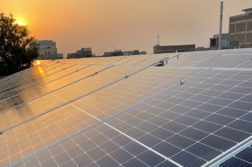In 2007, the ABC screened the British documentary, The Great Global Warming Swindle,
perhaps the best known popular explanation of the various untruths and
conspiracy theories that go by the name of "climate scepticism" or
"denialism". The screening of Martin Durkin’s documentary achieved two
things. Firstly, the fact that it was screened at all (reportedly over
the protestations of the ABC’s own science department) demonstrated how
afraid the ABC had become of the small cadre of right-wing columnists
who had built substantial, if intellectually negligible, careers out of
red-baiting the national broadcaster. Of course, this was never going
to appease the ABC-bashers like Connie Fierravanti-Wells or junior Liberal Party staffer Alexander Deane.
Secondly, it showed Australians, in graphic televisual detail, just how
paranoid, nutty and fringe the adherents of climate denialism really
are. It’s hard to present climate change denialism as objective science
when your spokespeople are followers of Lyndon LaRouche.
Durkin himself was forensically dissected by Tony Jones in an
embarrassing interview which quickly uncovered Durkin’s history of
fraud and the many deliberate distortions or errors of fact in his
documentary.
The debate on the reality of climate change is over, on any
scientific level. While there a few hold-outs among the more
scientifically challenged commentators on the right, in Australia the
special interest groups and the big corporations that fund them have
instead shifted the battle-ground to making sure they can extract the
maximum government patronage to luxuriously cushion their long-delayed
shift to paying for the climate-changing pollution they emit. So far,
this is a battle they have been winning handsomely.
The latest installment from the business lobby over carbon emissions is the Business Council of Australia’s paper Modelling Success: Designing an ETS that Works. This paper was commissioned by the BCA and authored by consultants Port Jackson Partners. It draws on confidential operational and financial data from 14 "facilities" that are likely to be affected by Penny Wong’s Carbon Pollution Reduction Scheme.
The paper argued that many of these facilities and/or businesses
would go broke at a carbon price of even $20 a tonne. Further, it cast
considerable doubt on whether Australia could actually meet a 20 per
cent reduction in greenhouse gas emissions by 2020. Indeed, it argues,
it will be tough for Australia’s electricity generators to build enough
new renewable electricity generation to even meet a target of 10 per
cent.
The paper was roundly criticised by many analysts, economists and environmentalists. Bernard Keene criticised it as "junk economics". Ross Gittins called it a "disillusioning plea for special treatment". Even the Chairman of oil giant BP, scarcely a disinterested observer, "expressed frustration" at the BCA’s paper and argued that Penny Wong’s emissions trading scheme was "sound".
The story of the BCA’s paper is more evidence that big business in
Australia doesn’t really "get it" when it comes to climate change.
Rather than seeing global warming as the existential threat to the
climate that humanity evolved in, Australia’s business lobby sees
climate change in the prosaic and simplistic context of a threat to
profitability and jobs.
The BCA: a history of pollution
The Business Council of Australia is one of Australia’s best-funded and
most influential pro-business lobby groups. Officially, it represents
the CEOs of Australia’s 100 largest companies. As it says on its website,
"the BCA was established in 1983 to provide a forum for Australian
business leadership to contribute directly to public policy debates".
But despite claiming to be committed to an Australia that "remains the
best place in which to live, to learn, to work and do business", the
BCA has been resolutely hostile to unions, environmentalists and
progressive politics in general.
The BCA’s politics are reflected in its people. Previous presidents include climate arch-skeptics Michael Chaney and Hugh Morgan,
the virulently conservative mining magnate who spent much of his career
attacking Aboriginal land rights and native title, the Kyoto Protocol
and the science of greenhouse, not to mention the rights of workers.
Morgan founded the Lavoisier Group of climate denialists as well as the
H.R. Nicholls Society of radical industrial relations reformers.
The BCA’s current president is Greg Gailey, the former CEO of zinc
miner Zinifex. In 2007 he stepped down earlier than expected after
overseeing a tenfold increase in Zinifex’s share price. For his efforts
he received a thankyou in the form of a $15 million payment.
Since that well-timed exit, Zinifex’s share price crashed back to
earth, falling by more than 50 per cent off its 2007 high, leading to a
merger this year with Oxiana to form OZ Metals. The merger also cast long-term doubt over who would pay for the extensive contamination of the Zinifex (formerly Pasminco) lead works in Port Pirie.
The BCA, in other words, is run by miners who know how to sell the politics of pollution.
Modelling Success — brought to you by the greenhouse mafia
If you dig deep enough into the BCA’s Modelling Success
paper, you discover that much of the actual modelling was carried out
by two other consultanices: ACIL Tasman and CRA International (since
renamed Concept Economics).
ACIL Tasman, in particular, has been widely commissioned by the
fossil fuel industries to issue warnings about the supposedly dire
consequences of a strict emissions cap.
But just who are these consultancies anyway? None other than the notorious "greenhouse mafia" that Guy Pearse investigated in his PhD
thesis and subsequent book, High and Dry.
The ACIL Tasman consultancy was formed via the merger of consultants
ACIL and the neoliberal think-tank, the Tasman Institute, by the Tasman
Institute’s founder Michael Porter. Porter made the move after his
previous think-tank, the Centre for Policy Studies, lost its funding.
Porter’s Tasman Institute had earlier teamed with Des Moore’s Institute
for Public Affairs to create the "Project Victoria" campaign, a set of
radical deregulation and privatisation policies that Jeff Kennett
largely put into practice.

Emo – carbon moguls
Porter became ACIL Tasman’s first Chairman
and appointed British whiz-kid Nick Morris, who was forced to resign in 2005 after a corporate espionage scandal in which he and a colleague were charged with hacking into competitor Access Economics’ email server.
ACIL Tasman is the consultancy supplying most of the modelling to the
big electricity generators and aluminium smelters in Australia, who
regularly employ the the consultancy to argue their case for favourable treatment.
It’s not surprising Guy Pearse calls ACIL Tasman one of the two "main fossil-fuel-friendly consultants". The other is CRA International/Concept Economics.
No methods, no bibliography
The BCA’s paper Modelling Success: Designing an ETS that Works
is not what most economists would describe as a rigorous piece of
research. It’s unlikely it would be accepted for publication by a
respectable economics journal. It contains no discussion of its
modelling methodology. The formulas used to construct the graphs are
not published. There is no discussion of relevant studies worldwide —
in particular the experience of European emitters following the
introduction of their emissions trading scheme. There isn’t even a
proper bibliography.
Further, as Ross Gittins pointed out in his recent column, the
assumptions that the paper proceeds from are questionable, to say the
least. "All modelling is only as good as the assumptions on which it
rests," wrote Gittins, "and you can get pretty much any result you want
by choosing the right assumptions".
In fact, Modelling Success doesn’t list its assumptions
anywhere. The careful reader has to deduce them from the wild claims
that the paper advances. As Gittins points out, three of its most
important assumptions are: "businesses have no scope to pass to
customers the cost of the emission permits they’ll need to buy, no
scope to eliminate wastefulness in their present use of fossil fuels
and no scope to reduce the need for permits by improving their
technology."
When I spoke to Rod Sims from Port Jackson Partners, he vigorously
defended these assumptions, particularly the first. Sims insists that
the truly trade-exposed industries really don’t have the ability to
pass on their costs. "The price for these commodities," he told me, "is
set at the London Metals Exchange".
But how true is this? BHP Billiton is Australia’s biggest greenhouse gas emitter. But even BHP only sells 15 per cent of its iron ore
on the world spot market. The reason? Spot markets are highly volatile.
They can go down as well as up. Both miners and customers prefer the
stability of a contract price. In fact, big miners and commodities
exporters deal with price volatility all the time.
In contrast to the hugely volatile markets at the London Metals
Exchange, both Penny Wong and Ross Garnaut are proposing a stable,
slowly rising price for carbon that may even be capped in the scheme’s
early years.
But Sims and Tarrant insist that even carbon at $10 per tonne will see
whole industries pack up and leave Australia for foreign shores where
they can pollute for free. This is the "carbon leakage" argument that
business has found so useful as they argue for free carbon permits from
the Australian Government. "Once it moves offshore, it’s not going to
come back," the BCA’s Maria Tarrant assures us. "If you put $5 million
or $10 million into infrasucture in Indonesia and you build capacity
there now to deal with Asia and Australia, you’re not going to come
back [to Australia]10 years later to replicate that infrastructure."
In this way the BCA uses carbon leakage to crank up the anxiety over
carbon pricing as a waste of time, and throws in the idea of jobs and
economic growth leaving the country.
The myth of carbon leakage
But it is the last assumption that Gittins deduces from BCA paper —
the assumption that affected businesses won’t invest in new technology
to lower their emissions — that is the most glaring. This is because it
conveniently ignores the international literature on "carbon leakage",
which is all about what economists call "induced technological change".
The best available new technology is less emissions-intensive than that
used in older, dirtier plants. As the European economists Carrado Di
Maria and Edwin Van Der Werf argue,
if technology "spills over" from developed to developing countries fast
enough, carbon leakage could actually be negative. In other words,
developing countries could actually reduce their emissions, even
without a carbon price.
This is not mere speculation. Although there is little empirical
data on the whole issue yet, the early evidence in Europe offers little
if any support to carbon leakage alarmists. As the authors of a March
2008 paper entitled The European Carbon Market in Action: Lessons from the First Trading Period wrote:
"we have not found empirical evidence demonstrating a correlation
between European carbon prices and a loss of competitiveness in the
industrial sectors included in our analysis."
The authors also point out that a decommissioned aluminium smelter
actually re-opened in Germany in 2007, despite a rising carbon price.
It’s important to remember where this BCA report fits into the
carbon price issue. Industries that are emitting carbon to produce
exports like aluminium and steel are only a small part of the economy,
and of total carbon emissions. Even if they did suffer from the
introduction of a carbon price, the amount of carbon leakage and the
effect on the rest of the economy would be relatively small.
As the authors of the Peterson Institute for International Economics paper Levelling the Carbon Playing Field
note, protecting these relatively small industries actually makes it
harder for the rest of the economy to function. Remembering that
Australia is going to cap its total carbon outputs, any move to give
these industries free permits to pollute means that every other
activity in the country is forced to emit even less so we stay beneath
that cap.
This is another reason why giving away free permits is such a bad idea.
What this all means, in a nutshell, is that this notion of carbon
leakage is not a valid reason why Australia should wait for the world
to act on carbon emissions. We are certainly in no danger of acting too
fast on this. As John Quiggin notes, by the time we get our act together, we may well be bringing up the rear.
A flair for hypocrisy
The carbon leakage "debate" reveals the hypocrisy and self-interest
that often masquerades as genuine contributions to the climate change
policy debate. While big business and their associated web of
think-tanks and consultancies have long argued that we should wait for
more scientific certainty that climate change is really happening
before imposing a price on carbon (or taking any other action), they
have happily demanded enormous hand-outs based on flimsy and skewed
"research".
In comparison to the vast body of peer-reviewed, statistically sound
evidence that our planet is warming, the jury is still very much out on
the phenomenon of carbon leakage. Indeed, as we have seen, companies
leaving Australia to set up new, low-emissions plants may even reduce
the world’s long-term emissions trajectory.
That’s an argument we haven’t heard from the Business Council of
Australia yet. The evidence suggests that Australia’s business lobby
will continue to fight sensible efforts to mitigate climate change in
the interests of expediency and greed.
Donate To New Matilda
New Matilda is a small, independent media outlet. We survive through reader contributions, and never losing a lawsuit. If you got something from this article, giving something back helps us to continue speaking truth to power. Every little bit counts.



